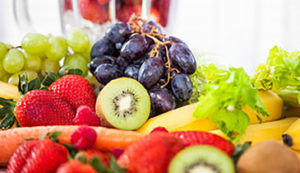 We all have heard some variation of this nutritional advice since we were kids: “Eat your veggies, finish your fruit.” It’s abundantly clear that eating lots of vegetables and fruits helps reduce inflammation, and eating more plants can help you avoid conditions like heart disease, stroke, high blood pressure, diabetes and more.
We all have heard some variation of this nutritional advice since we were kids: “Eat your veggies, finish your fruit.” It’s abundantly clear that eating lots of vegetables and fruits helps reduce inflammation, and eating more plants can help you avoid conditions like heart disease, stroke, high blood pressure, diabetes and more.
What does “lots” mean? The latest dietary guidelines call for five to 13 servings of fruits and vegetables a day (2½ to 6½ cups per day), depending on one’s caloric intake. For a person who needs 2,000 calories a day to maintain weight and health, this translates into nine servings, or 4½ cups, per day, including 2 cups of fruit and 2½ cups of vegetables.
For most fresh or cooked vegetables and fruits, 1 cup is just what you would put in a household measuring cup. There are two main exceptions to that rule: For lettuce and other raw leafy greens, you need to eat 2 cups to get the equivalent of 1 cup of vegetables. For dried fruit, you only need to eat ½ cup to get the equivalent of 1 cup of fruit.
Many people find eating this many servings of fruits and vegetables every day challenging, and the failure rate is high. When I advise patients to load up their diet with the benefits of vegetables and fruits, I offer them some shortcuts, hoping they’ll adopt them to enjoy the benefits of plant-centric nutrition.
Some of these shortcuts to reach 50 shades of green (or even nine) include:
1. Keep fruit out and in plain sight. That way you’ll be more likely to eat it. Keep it out on the counter or in the front of the fridge.
2. Get some every meal, every day. Try filling half your plate with vegetables or fruit at each meal. Serving up salads, stir-fry, or other fruit- and vegetable-rich fare makes it easier to reach this goal.
3. Pack snacks of whole fruits and vegetables daily. One of the great things about plants is that many of them come in their own packaging; you don’t need to do any prep to throw an apple or orange in your bag!
4. Explore the produce aisle and choose something new. Variety is the key to a healthy diet. Get out of a rut and try some new fruits and vegetables.
5. Consider a green smoothie. Handfuls of berries along with cups of kale, spinach, arugula, or parsley can start your day with several servings.
6. Consider a plant-based flavored powder in your morning coffee. I learned this hack at my local health club, where they offered to add a mix of coffee with a tasty blend of vegetables, chlorella, kelp, turmeric and kale. This actually tasted great, a lot like hot chocolate or hot mocha, and is a regular habit of mine.
7. Consider a green powder in your smoothie. Although the staple of a morning green smoothie should be whole vegetables and fruits, a greens-based powder can add another serving or two easily. My current favorite is a combination of green vegetable powders with the adaptogen herb maca, which really makes the day exciting.
8. Juice your vegetables (and fruits). I acknowledge that there is a debate between the health benefits of juicing versus smoothies, but in light of the terrible track record of eating adequate servings of vegetables and fruits in the Western world, I welcome a juice advocate any day. Although juicing creates a brew low in fiber, the rich supply of vitamins, phytonutrients and such more than makes up for this deficiency. I favor fresh-pressed juices that are about 80% vegetable, largely green, and have the remainder composed of fruits like green apple or pear. Just be sure to get your fiber, too, from whole fruits, vegetables, nuts, seeds and legumes.
9. Consider a fruit-and-vegetable concentrated capsule. If all else fails, if you simply can find no other way to add the rainbow colored produce department to your diet, then there are capsule with concentrated blends of vegetables and fruits. Most health stores will carry a few options, and you can find one that works for you.
For now, I don’t foresee an app that will automatically add the health benefits of fruits and vegetables to your daily routine. Unless a radical breakthrough occurs in technology, you’ll have to gut it up and eat, drink or swallow mouthful by mouthful your vitamins, minerals, fiber, antioxidants, and phytonutrients in the form of produce.
Eat your fruits and veggies; they taste so much better than insulin, statins, heart surgery, stents or chemotherapy.




